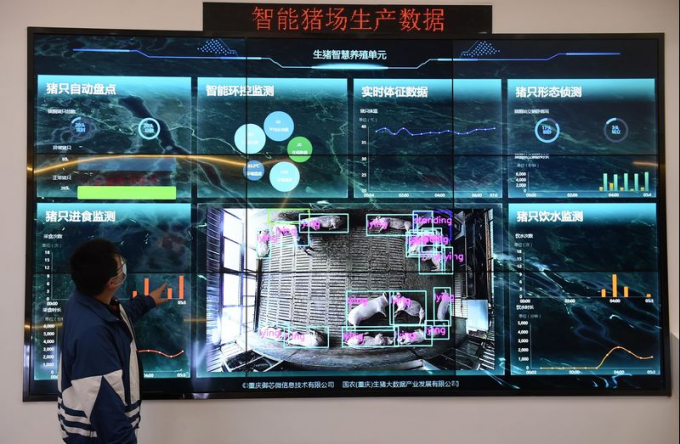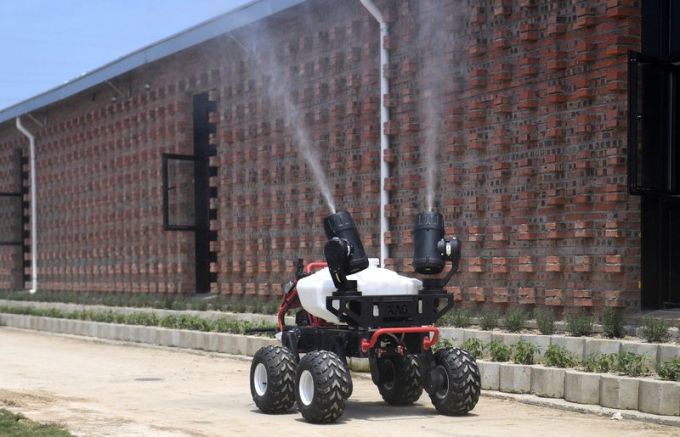November 25, 2025 | 21:44 GMT +7
November 25, 2025 | 21:44 GMT +7
Hotline: 0913.378.918
November 25, 2025 | 21:44 GMT +7
Hotline: 0913.378.918

An automatic temperature and humidity controller at a pig farm in Jiaxing, Zhejiang Province, earlier in April. Photo: Wang Gang/China News Service/Getty Images
That’s the height of a building in southern China where more than 10,000 pigs are kept in a condominium-style complex, complete with restricted access, security cameras, in-house veterinary services and carefully prepared meals.
The seemingly luxurious conditions represent a state-of-the-art approach to biosecurity in which pigs -- the main source of meat in China -- are shielded from viruses, including the devastating African swine fever that wiped out half the nation’s hogs in the two years before the coronavirus pandemic emerged.
Nicknamed “hog hotels,” these gigantic vertical farms are being built by companies, including Muyuan Foods and New Hope Group, emulating the strict controls major suppliers in other countries have used to prevent outbreaks of the devastating disease.
China is copying best-practices from Europe and the U.S. to close its biosecurity gap, said Rupert Claxton, the U.K.-based meat director at consultant Gira, who has been providing advice to farmers and businesses for two decades. “In 20 years, it’s done what the Americans took probably 100 years to do,” he said.
Lethal African swine fever, which sickens pigs much like Ebola kills humans, caused a dramatic outbreak in China in 2018. Within a year, roughly half the nation’s herd of more than 400 million pigs had been wiped out -- more than the entire annual output of the U.S. and Brazil combined -- leading to rocketing prices and unprecedented imports.

A real-time display screen at a smart pig farm at National Hog Big Data Center in Chongqing, China in 2020. Photo: Getty Images
Food security became a top priority, and as inflation surged to the highest in eight years, the government had to turn to emergency sources of frozen meat to cool prices. New agriculture policies were instituted to accelerate a shift to large-scale, industrial operations over backyard farms that have traditionally fattened pigs on raw kitchen scraps and swill -- the main sources of African swine fever.
Now, domestic hog numbers recovered more swiftly than anticipated because mega farms have expanded capacity so aggressively. Wholesale pork prices have tumbled so much that it tripped the government’s new alert system, prompting authorities to begin buying pork for state reserves and to shore up the market.
Still, the virus threat persists, with 11 incidents reported so far in 2021, prompting the culling of more than 2,000 pigs, China’s farm ministry said in July. The emergence of new strains that appear to cause milder symptoms and have a longer incubation period are complicating efforts to detect and respond to outbreaks, the ministry said.
In developed countries, pig production is dominated by bigger farms in fewer hands. This has been seen for decades in the U.S., Denmark and Netherlands, which have among the best biosecurity standards globally and never reported a single African swine fever outbreak in recent years.
These days, mega pig complexes that don’t rely on other farms for sows, fodder and labor -- which risk introducing pathogens -- are a pillar of China’s food security. As of 2020, 57% of the country’s pig production is from farms supplying more than 500 hogs a year. Before the outbreak, only about 1% came from larger suppliers.

A disinfection robot works outside a pig farm in Jiaxing, in April.Photo: Getty Images
New Hope Group recently completed three five-story buildings across an area the size of 20 football fields, or 140,000 square meters (1.5 million square feet), in Beijing’s eastern Pinggu district. The facility, which can be smelled from about a kilometer away, will eventually produce 120,000 pigs annually, making it the largest in the Beijing area.
It’s equipped with robots that monitor animals for fever, air filtration, and automatic feeding and disinfection systems, according to Gong Jingli, the supervisor in charge. A request to visit was declined on biosecurity grounds.
That’s in part because the scale of these farms means more is at stake. With thousands of pigs housed in close proximity, an infectious disease could spread rapidly.
Strict protocols are enforced to minimize risks. Staff are required to shower and change their clothes on entering and exiting the facility -- much like scientists working in biosafety laboratories. Wristwatches must be left outside.
Tom Gillespie, a U.S.-based swine veterinarian with 40 years of experience and who visits farms in Asia annually, said he was asked to remove his wedding band before entering a facility in China, but was allowed to keep his spectacles on. The requirement was a reaction to African swine fever, he said, and may be relaxed once operators are more familiar with managing biosecurity risks.
Some mega farms have built staff dormitories to try to limit workers’ contact with the “outside” -- a strategy Gillespie said would be difficult to implement in other countries.
So far, large-scale farms in China have also avoided many of the restrictions applied to their overseas counterparts because of animal welfare and environmental concerns.
“In Europe and U.S., there are restrictions on how big we can make a pig farm because people just object -- they don’t want to live next to these huge sites,” said Gira’s Claxton. “In China, that doesn’t seem to be the case. If it’s decided that a pig farm is needed, then the space is available.”
Expanding vertically is a popular option in a country lacking vast tracks of empty space. Rapid urbanization has diminished land available for agriculture, and environmental regulations have made intensive animal production increasingly difficult in metropolitan areas.
High-rise blocks can cut farmland use by a third compared with traditional farms with the same number of pigs, and there’s flexibility in terms of location as some can be built on mountains, said New Hope’s Gong. Wastewater from the Pinggu plant is treated and used to irrigate orchards nearby, while the solid waste is turned into fertilizer, Gong said.
Muyuan Foods, China’s largest hog breeder, said it has land available to support 100 million hogs. Jiangxi Zhengbang Technology, the second-biggest, has said its herd may eventually reach a similar size.
The rise of large hog farms also reflects shifting diets in China. Whereas Beijing focused on fighting hunger and eliminating poverty in past decades, rapid economic development and expanding incomes mean China’s 1.4 billion people are eating more meat, eggs and other animal proteins. That’s driving more-intensive animal production.
“China is the world’s largest pork-consuming nation, and I don’t see that changing very easily or any time soon,” said David Ortega, associate professor of Food and Agricultural Economics at Michigan State University in East Lansing. “Rebuilding the pork sector is a national priority for the government.”
(Bloomberg)

(VAN) Brazil's COP30 presidency pushed through a compromise climate deal on Saturday that would boost finance for poor nations coping with global warming but that omitted any mention of the fossil fuels driving it.

(VAN) Poultry farmers in the UK have been warned that they could face one of the worst winters yet for bird flu.

(VAN) Prices of main-crop paddy have risen sharply, with jasmine rice hitting 16,100 baht per tonne — the highest level in years.

(VAN) In Brazil, FAO unveiled a series of reports and initiatives showing how sustainable agrifood systems are a solution to the climate crisis.

(VAN) With names like neodymium and dysprosium, rare-earth elements sound exotic — and their perceived scarcity has only added to the mystique.

(VAN) In a new study published in Trends in Biotechnology, researchers used a gene-editing technology called CRISPR to increase a fungus's production efficiency and cut its production-related environmental impact by as much as 61%- all without adding any foreign DNA.

(VAN) A top official in Beijing’s Cop delegation says China is committed to clean energy – but US’s absence is a problem.